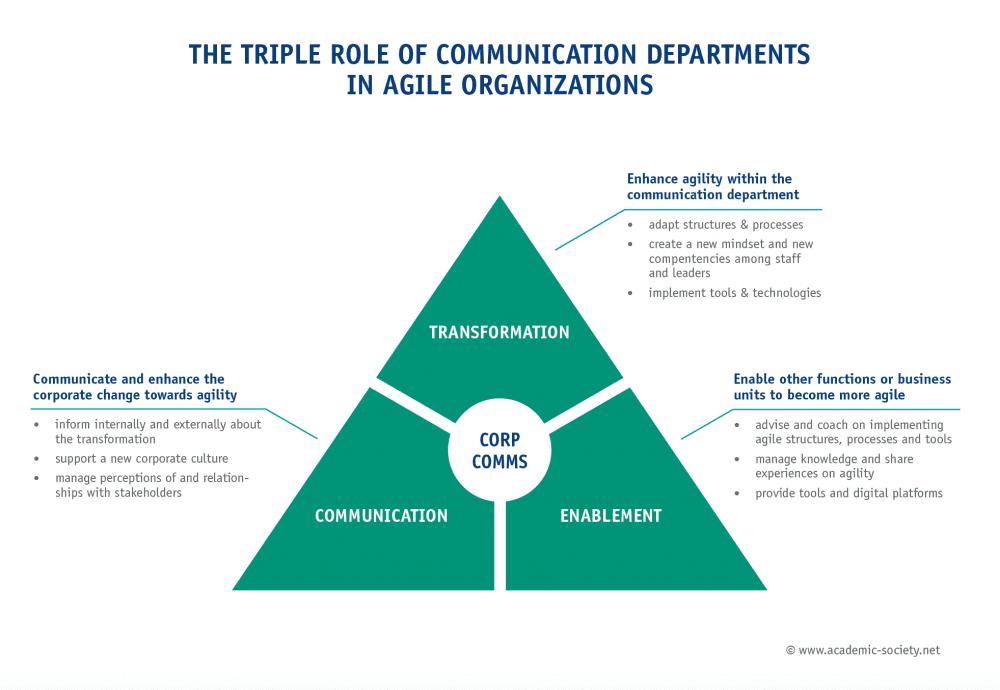
Unpredictable, dynamic environments and the challenges of digitalization force many corporations to question traditional ways of organizing their activities. A big idea often discussed by top management in this context is “agility” – meaning that organizations should become significantly more flexible, faster and responsive by establishing new ways of planning (design thinking, scrum), organizing (multilateral project teams, more collaboration, less rules), and stakeholder interaction. This poses many challenges on corporate communications. Communication leaders might be leading the change towards agility in their organizations, or their departments might be affected by change initiated in other parts of the organization. In both cases, the question of ‘how to’ is the most pressing one.
What does it mean to be agile?
Organizational theory has explored the problem of how organizations cope with complex, uncertain, volatile environments since the 1960s. The more specific concept of agility has been introduced in the 1990s and was adopted especially by researchers in the fields of production or supply chain management, software development, and information technology. However, it is still a broad term that encompasses a multitude of concepts, methods, and tools. A comprehensive definition based on an interdisciplinary literature review is shown in the box below. Although many communication departments strive to become fast and flexible, research has almost completely neglected this topic. Until recently, only one journal article linking agile methods to communication management has been published worldwide (Van Ruler, 2015).
Defining Agility: “Agility is the overall capability of an organization to respond to and take advantage of the changes initiated by the drivers in the internal and external environments. It includes the ability to identify relevant changes and to respond proactively, efficiently and effectively, employing the right personnel based on competence, not hierarchical status. Additionally, it includes the ability to implement flexible structures and processes suited to the immediate tasks at hand and to employ the appropriate resources in the shortest possible time.” (Zerfass et al., 2018, p. 7).
Researching agility in communications
A research team at the University of Leipzig, Germany, started to research different aspects of agility in corporate communications in autumn 2017. The project is supported by the Academic Society of Communication & Management, a group of 40 global blue-chip companies in Western Europe. The project started by conducting a systematic, interdisciplinary literature review in general management, organizational theory, production economics, supply chain management, and information technology, thereby analyzing several conceptual frameworks and synthesizing the relevant aspects for communications. Secondly, the team conducted explorative interviews with 38 chief communication officers and senior communication managers in spring 2018. Interviewees were asked about the status quo of different aspects of agility (strategy, structure, culture, instruments, tools, people) in their company in general and their communication department specifically. Additionally, in-depth case studies within selected companies lasting between two days and two weeks were conducted to identify different approaches towards agility. First results of this project have been published in a report that is available online (Zerfass et al., 2018).
Six providers of agility
The findings show that, first of all, it is important to understand that becoming agile is not only about introducing tools and technologies (e.g. Kanban, Design Thinking, Scrum), instead, what it requires is most of all a change of mindsets and attitude. Second, it might require new organizational structures and processes, as well. The empirical insights supported the findings from the literature: six overall factors drive agility:
- Structures & Processes: Agile structures and processes are an important prerequisite for flexibility and speed. Linear, bureaucratic structures with rigid chains of command often make decisions slow and ineffective. Working in functional silos creates redundancies and a lack of information and transparency. Thus, agile departments work towards flatter hierarchies, decentralize power, establish iterative decision-making processes, and set up cross-functional teams.
- Culture & People: Agile organizations come to life through the people working within them. Creating a different mindset and corporate culture are probably the most important providers of agility. Executives and team members alike require openness and willingness to work in cross-functional teams with a stronger emphasis on collaboration, interaction, self-management, and knowledge sharing. Incentives and career options need to be revised when leadership positions are dismantled.
- Tools & Technologies: A number of agile methods or tools such as Scrum, Design Thinking or Kanban are helpful when working towards an agile organization. Furthermore, technologies such as digital collaboration tools and knowledge management platforms support agile work flows.
Challenges and opportunities for communication leaders
Overall, communication departments might play a triple role in agile organizations. Best-practices show that it is often not only about becoming more flexible oneself, but about facilitating a change throughout the whole corporation.

The triple role of communication departments in agile organizations
Positioning the corporation as agile and flexible in the media and in the minds of stakeholders can be an objective of communications, even for departments that are not agile themselves. Enabling others in the organization to become more agile offers new opportunities for communicators. That is often done hand in hand with HR. But in the end it is all about leveraging change and introducing new internal communication processes, so practitioners might be those who are most knowledgeable in their organizations. Last but not least, transforming the communication function itself is a key challenge for any communication leader.
Most common: “Islands of agility”

Our research reveals that only very few companies, such as ING, a leading international direct bank headquartered in The Netherlands, or Deutsche Telekom, well-known in the United States for its T-Mobile brand, have radically restructured their communication departments. For example, more than 120 communicators at the Telekom headquarters in Bonn, Germany, work without hierarchies in temporarily assigned teams. Other corporations, such as the global healthcare solution provider B. Braun (62,000 employees), have established “islands of agility” – they run dedicated strategic projects in agile teams, but continue to operate in a traditional structure for day-to-day work.
There is no one best way to deal with agility. Communication leaders must individually assess their organization, their department, and their team and reflect on which agility dimensions and strategies are beneficial in order to make them faster, more productive, and efficient.
References
Van Ruler, B. (2015). Agile public relations planning: The reflective communication scrum. Public Relations Review, 41(2), 187-194.
Zerfass, A., & Dühring, L. (2018). The agile way. Communication Director, 13(2), S. 42-44.
Zerfass, A., Dühring, L., Berger, K., & Brockhaus, J. (2018). Fast and flexible. Corporate communications in agile organizations (Communication Insights, Issue 5). Leipzig, Germany: Academic Society for Management & Communication. Free download at http://www.akademische-gesellschaft.com/en/service/publikationen/communication_insights/.
About the Authors
 Dr. Ansgar Zerfass is Professor and Chair of Strategic Communication at Leipzig University, Germany, and Editor of the International Journal of Strategic Communication (Routledge, USA). He received the Institute for Public Relations’ Pathfinder Award and the PRSA Jackson Jackson Wagner Award. His published work includes 35 books and more than 320 journal articles, book chapters and study reports on corporate communications and publics relations. zerfass@uni-leipzig.de
Dr. Ansgar Zerfass is Professor and Chair of Strategic Communication at Leipzig University, Germany, and Editor of the International Journal of Strategic Communication (Routledge, USA). He received the Institute for Public Relations’ Pathfinder Award and the PRSA Jackson Jackson Wagner Award. His published work includes 35 books and more than 320 journal articles, book chapters and study reports on corporate communications and publics relations. zerfass@uni-leipzig.de
 Dr. Lisa Dühring is a post-doctoral researcher at Leipzig University. She has worked as an academic in Europa and New Zealand and published internationally on strategic communication, critical PR theory, and the philosophy of science of marketing and public relations scholarship. duehring@uni-leipzig.de
Dr. Lisa Dühring is a post-doctoral researcher at Leipzig University. She has worked as an academic in Europa and New Zealand and published internationally on strategic communication, critical PR theory, and the philosophy of science of marketing and public relations scholarship. duehring@uni-leipzig.de



